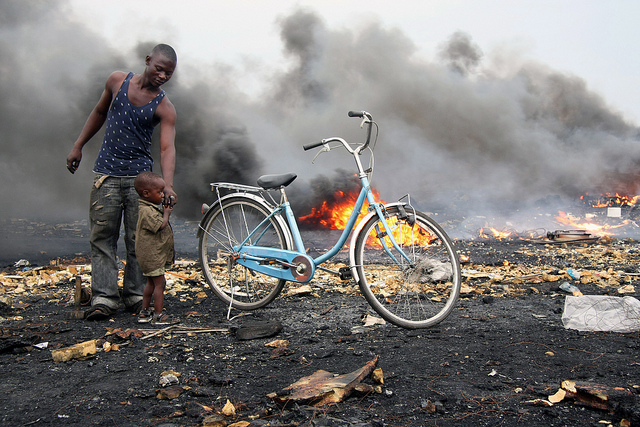World's 10 Worst Polluted Places Named

Remote industrial towns, e-waste processing centers and the site of an infamous nuclear disaster top 2013's worst polluted places, according to a new list from the New York-based nonprofit Blacksmith Institute.
The toxic locations are not ranked, but they include Chernobyl, Ukraine, which is still suffering the consequences of a radioactive meltdown that occurred in 1986; the Niger River Delta in Nigeria, where each year 240,000 barrels of crude oil are spilled; and Hazaribagh, Bangladesh, where carcinogens enter the water supply from more than 200 tanneries concentrated in a small area of the city.
"In this year's report, we cite some of the most polluted places we've encountered. But it is important to point out that the problem is really much larger than these 10 sites," Richard Fuller, president of the Blacksmith Institute, dedicated to eliminating life-threatening polluting in developing countries, said in a statement. "We estimate that the health of more than 200 million people is at risk from pollution in the developing world." [See Images of the Most Polluted Places]
According to the report, the World Health Organization (the public health arm of the United Nations) has estimated that 23 percent of deaths in the developing world can be attributed to environmental factors like pollution. Besides cancer, exposure to toxic chemicals can cause acute and chronic poisoning, cognitive impairment, organ damage and respiratory problems, the report said, adding that children are most vulnerable to these impacts.
Researchers said the 10 sites were chosen based on the severity of their health risk and prioritized by their value as examples of different kinds of pollution threats around world.
Here are the 10 sites listed in the report, in alphabetical order:
Agbogbloshie, Ghana: This dumpsite in the Ghanaian capital Accra is the second largest e-waste processing area in West Africa. When sheathed cables from electronics like microwaves and computers are burned to recover the copper material inside, metals can particulate in the smoke and get left behind in the soil. An estimated 40,000 people are affected by the pollution threat.
Get the world’s most fascinating discoveries delivered straight to your inbox.
Chernobyl, Ukraine: The world's worst nuclear disaster at Chernobyl in 1986 released 100 times more radiation than the atom bombs dropped over Hiroshima and Nagasaki. Skin lesions, respiratory ailments, infertility and birth defects affected people in contaminated areas in Belarus, Russia and Ukraine for years and the accident has been linked to more than 4,000 cases of thyroid cancer. Pollution from Chernobyl is estimated to have affected some 10 million people.
Citarum River, Indonesia: More than 500,000 people are directly affected, and up to 5 million people are indirectly impacted, by chemical pollution in the Citarum River Basin in West Java. Lead, aluminum, manganese and iron concentrations in the river are several times higher than world averages because of pollution from industrial and domestic sources.
Dzershinsk, Russia: A major site of chemical manufacturing in Russia, Dzershinsk has high levels of pollutants like dioxins and phenol in the groundwater. Residents suffer from diseases and cancers of the eyes, lungs and kidneys and life expectancy in the city is just 47 for women and just 42 for men.
Hazaribagh, Bangladesh: Tanneries using old, outdated and inefficient processing methods to make leather dump 22,000 cubic liters of toxic waste each day into the city's main river, impacting more than 160,000 people. This waste includes the cancer-causing chemical hexavalent chromium.
Kabwe, Zambia: Decades of unregulated lead mining in this African city have caused serious health problems for residents of Kabwe, where more than 300,000 people are thought to be affected by pollution. In 2006, children's blood lead levels in Kabwe were found to exceed the recommended levels by five to 10 times.
Kalimantan, Indonesia: On the island of Borneo, Kalimantan and the surrounding areas have become contaminated with mercury because of small-scale gold mining, impacting some 225,000 people. Miners in the region use mercury in the gold extraction process, resulting in mercury emissions during the amalgamation and smelting processes.
Matanza Riachuelo, Argentina: More than 15,000 industries are thought to be releasing a variety of pollutants into the Matanza River, which passes through Buenos Aires and empties into the Rio de la Plata. Contaminants include zinc, lead, copper, nickel and total chromium (a term that includes two forms of chromium), making the drinking water near the Matanza-Riachuelo river basin seriously unsafe, threating more than 20,000 people who live in the area.
Niger River Delta, Nigeria: An unknown number of people are impacted by the voracious petroleum industry in this densely populated part of Africa, where there were nearly 7,000 incidents involving oil spills between 1976 and 2001. The report said that about 2 million barrels of oil were being extracted from the delta every day as of last year.
Norilsk, Russia: Norilsk is an industrial city in Siberian Russia, where each year, nearly 500 tons each of copper and nickel oxides and 2 million tons of sulfur dioxide are released into the air. Life expectancy for factory workers in Norilsk is 10 years below the Russian average.\
Editor's note: An earlier version of this article incorrectly stated that Kabwe was in Zimbabwe. It is in Zambia.
Follow Megan Gannon on Twitter and Google+. Follow us @livescience, Facebook & Google+. Original article on LiveScience.

